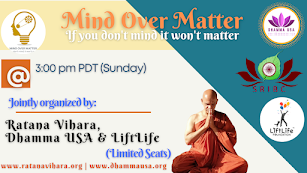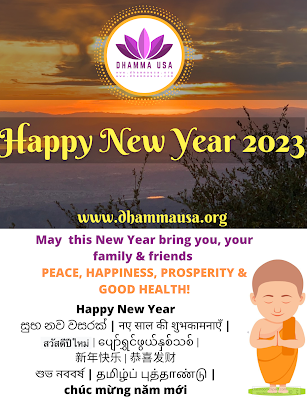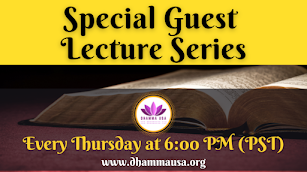Cultivating a Balanced Personality Through the Buddha-Dhamma: A Guide to Practical Living
By Nivitigala Sumitta Thero (Bhante Sumitta)
The Buddha-Dhamma is a practical guide to life, intended to be actively integrated into our daily existence rather than merely read and forgotten. Its ultimate goal is Nibbana, or liberation from suffering, while its immediate purpose is to help us address everyday challenges, leading to a well-rounded, happy, and balanced life in harmony with others and our environment. However, achieving this balance is difficult in a world filled with false ideologies and superficial values.
Buddhism offers genuine, absolute truths that can be tested through personal experience. It promotes clear thinking, self-control, and mental cultivation, laying a strong foundation for success in life. While fulfilling worldly responsibilities, one should view lay life as preparation for Nibbana.
The Maha-Mangala Sutta highlights the importance of having a "properly directed mind," which involves recognizing one's place in the world, setting meaningful goals, and following a sound life philosophy. A balanced person possesses a clear aim and a philosophy that fosters understanding of human existence, allowing for harmony with oneself and others.
In Buddhism, the mind's purpose guides life choices, and self-awareness through introspection enhances self-improvement. Evaluating personal qualities like generosity and kindness contributes to developing a well-adjusted character. Regular practice leads to habit formation, ultimately shaping one's character.
Mindfulness, or sati, involves objective observation of reality without biases, which signifies true maturity in Buddhism. Applying this principle can lead to clearer thinking, improved relationships, and resilience against societal pressures.
A balanced Buddhist must think independently and make personal decisions based on Buddhist principles, rather than conforming to societal expectations. While seeking guidance is valuable, the final choice must be one's own.
Recognizing the link between craving and suffering, a Buddhist should maintain detachment from material possessions and adhere to the Five Precepts, promoting overall well-being. Ethical character development is essential for wisdom and achieving Nibbana.
Life's inherent changes may bring disappointments, but facing them with equanimity demonstrates right understanding of causality. This perspective allows individuals to cope with injustices and emotional challenges through the principles of kamma and rebirth.
A Buddhist cultivates a philosophical mindset, relying on wholesome actions, character strengths, and the benefits of meditation, fostering self-sufficiency. Understanding the impermanence of material things helps in achieving contentment, which the Buddha considers the greatest wealth.
With confidence in the Buddha-Dhamma, practitioners should actively cultivate positive mental states and engage in self-reflection and meditation. Reading Buddhist texts regularly can also provide perspective and alleviate minor troubles.
Through these practices, lay disciples of the Buddha develop a well-rounded personality, enhancing their intellect, emotional health, and willpower for the benefit of themselves and others.
Critical Analysis
The text presents a comprehensive examination of how the Buddha-Dhamma can be applied to achieve a balanced personality in contemporary life. It effectively underscores the practical nature of Buddhist teachings, advocating for their integration into daily existence. By emphasizing the importance of applying the Dhamma, the text critiques a superficial understanding of spirituality that remains untested in personal experience.
The discussion on Nibbana as both a distant goal and an immediate objective highlights the duality of spiritual practice in Buddhism. It encourages individuals to see lay life as preparatory rather than separate from spiritual aspirations, fostering a holistic approach to personal development. This perspective is particularly relevant in today's fast-paced world, where individuals often compartmentalize their spiritual lives from their daily responsibilities.
The text's focus on self-awareness and introspection aligns well with modern psychological practices, emphasizing emotional intelligence and self-improvement. By advocating for qualities such as kindness and honesty, it provides practical tools for character development that are universally applicable.
However, while the text addresses individual growth, it may benefit from exploring the societal implications of a well-balanced personality more deeply. The emphasis on individualism might overlook the interconnectedness of personal and communal well-being, which is vital in addressing broader social challenges.
The principle of sati, or mindfulness, is highlighted as a crucial aspect of Buddhist maturity. This focus on objective observation is essential for fostering clarity and resilience against external pressures, particularly in the age of information overload and media influence.
The call for independent thinking and moral courage is particularly pertinent, as it encourages individuals to resist conformity and make choices aligned with their values. This emphasis on personal agency empowers practitioners to navigate life's complexities while adhering to ethical principles.
Overall, the text presents a compelling framework for cultivating a balanced personality through the application of Buddhist teachings. It resonates with contemporary readers seeking meaningful ways to integrate spirituality into their lives, fostering both personal growth and harmonious relationships.
***********************************************************************************
Here’s a structured outline with subtopics for the essay. This structured approach can help guide readers through the essay, making it easier to follow the key concepts and insights related to cultivating a balanced personality through Buddhist teachings.:
Cultivating a Balanced Personality Through the Buddha-Dhamma: A Guide to Practical Living
1. The Practical Application of Buddha-Dhamma
• The relevance of the Dhamma in daily life
• Transitioning teachings into action
2. Nibbana: The Ultimate Goal of Buddhist Practice
• Understanding Nibbana as liberation from suffering
• Immediate objectives of Buddhist practice
3. Finding Balance in a Chaotic World
• Challenges of contemporary ideologies and values
• The quest for harmony in personal and social contexts
4. True Values vs. Illusory Ideals
• The distinction between absolute and relative values
• Testing Buddhist truths through personal experience
5. The Importance of Clear Thinking and Self-Control
• Developing mental clarity as a foundation for life
• The role of self-discipline in achieving balance
6. A Philosophy for Harmonious Living
• Defining a personal philosophy based on Dhamma
• The impact of philosophy on interpersonal relationships
7. Self-Observation: The Path to Self-Improvement
• Techniques for introspection and self-analysis
• Cultivating positive personal qualities
8. Mindfulness as a Tool for Clarity
• Understanding sati (mindfulness) in daily practice
• Benefits of objective observation in life
9. The Role of Personal Agency in Spiritual Growth
• Encouraging independent thought and decision-making
• The importance of moral courage in facing societal pressures
10. Ethical Development and Its Impact on Well-Being
• The Five Precepts and their significance
• Building a foundation of moral character
11. Cultivating Resilience in the Face of Life’s Challenges
• Developing equanimity during disappointments
• Understanding the principles of kamma and rebirth
12. The Interconnectedness of Individual and Community Well-Being
• The impact of individual growth on societal health
• The importance of community support in personal development
13. Empowering Choices Through Buddhist Principles
• Making informed decisions based on Dhamma
• The balance between seeking advice and personal autonomy
14. The Journey to a Well-Rounded Personality
• The continuous process of growth and learning
• Integrating the teachings of the Buddha into all aspects of life


















































